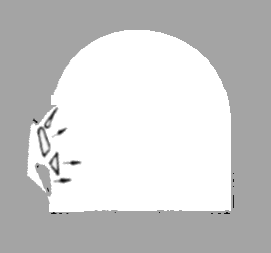Research Project
Rock Properties to Predict Rockburst Vulnerability in Three Dimensions (Strainburst)
Project Leader: Professor Phil Dight
This ACG research project, funded by Minerals Research Institute of Western Australia (MRIWA) aimed to equip the mining industry with knowledge to mitigate strainburst/rockburst risk.
As mines continue to extend deeper and open pits expand, strainbursts and rockbursts are increasing the cost of mining safely, i.e. ground support requirements, microseismic monitoring, restrictions to production and sequencing, as well as delays in re-entry, sometimes leading to the premature closure of a mine. These problems are a major threat to the future exploitation of deep resources. Several strainburst/rockburst risk management approaches are available and are currently used by many mines. However, once the mining method and sequence are determined, the hazard state is more or less locked in, leaving implementation of appropriate support as one of the only short-term controls of excavation damage potential. Knowledge of the location of potential bursts is key to appropriate and timely selection. To aid industry to design more appropriate support systems to mitigate the potential problem, in 2016, the ACG commenced an industry and Minerals Research Institute of Western Australia (MRIWA) funded research project into Rock properties to predict rockburst vulnerability in three dimensions (MRIWA Project M0464). The project was completed in December 2021.
Project objectives
This ACG research project examined the properties of rocks in 3D. This work identified the principal components of many rock properties in 3D including the pre‐peak and post‐peak behaviour Brazilian tensile strength and fracture toughness in order to identify where rockburst could occur. Pre-peak behaviour is dominated by rock brittleness and fracture generation.
Dight et al. (2013) have shown that the energy from the self‐sustaining behaviour can be related to the ejection velocity once the rockburst potential can be identified, which means that the demand on and parameters for ground support may be determined for dynamic situations.
The ultimate benefit of the project to the mining industry will lead to much better management of hazards and early adoption of mitigation approaches. Thus, fewer mines would be closing due to rockburst. The project may benefit mines by helping to identify approaches for reducing the consequences of rockbursts, in particular, by designing more appropriate support systems. This will contribute to making deep mines safer and more sustainable in the future.
The research project team explored:
- In situ stress recovery
- Pre‐peak intact properties
- Post‐peak properties (energy demand from Type 2 behaviour)
- Demand for the design of dynamic support
The research project team
The project team was led by the ACG’s Professor Phil Dight and comprised the following researchers:
- Dr Hongyu Wang, research associate, formerly Australian Centre for Geomechanics
- Dr Ariel Hsieh, research fellow, formerly Australian Centre for Geomechanics
- Dr Selahattin Akdag, research fellow, formerly Australian Centre for Geomechanics
- Ai Li (Ellie), laboratory technician, Australian Centre for Geomechanics
- Professor Arcady Dyskin, chair, Computational Mechanics Discipline Group, The University of Western Australia
- Adjunct research associate Max Lee, geotechnical specialist, Monash University
- Dr Hossein Hasoumi, senior lecturer, Monash University
This team was supported by the following PhD candidates:
- Broadus Jeffcoat-Sacco, The University of Western Australia (ACG)
- Ali Keneti, Monash University
Collaborating universities
The majority of the research work was conducted at The University of Western Australia. Research undertaken by Monash University included the consideration of pre-peak and dynamic studies through the application of geological investigations and numerical modelling in three dimensions.
Project sponsors
- Minerals Research Institute of Western Australia
- Aeris Resources, Tritton Resources Limited
- Agnico Eagle Mines Limited, LaRonde Mine
- AngloGold Ashanti Australia, Sunrise Dam Gold Mine
- BHP Nickel West
- BHP Olympic Dam
- Ernest Henry Mining Pty Ltd
- Gold Fields Australia Pty Ltd, Granny Smith Mine
- Gold Fields Australia Pty Ltd, Agnew, South Deep and St Ives Gold Mines
- IAMGOLD Corporation, Westwood Mine
- Luossavaara-Kiirunavaara AB, Kiruna and Malmberget Mines
- Newcrest Mining Limited, Cadia Valley Operations
- Northern Star Resources Limited, Kalgoorlie Operations
- Sudbury Integrated Nickel Operations (a Glencore Company), Nickel Rim South Mine
If you are interested in further research in this subject area, please contact the ACG. Article references are available on request.

